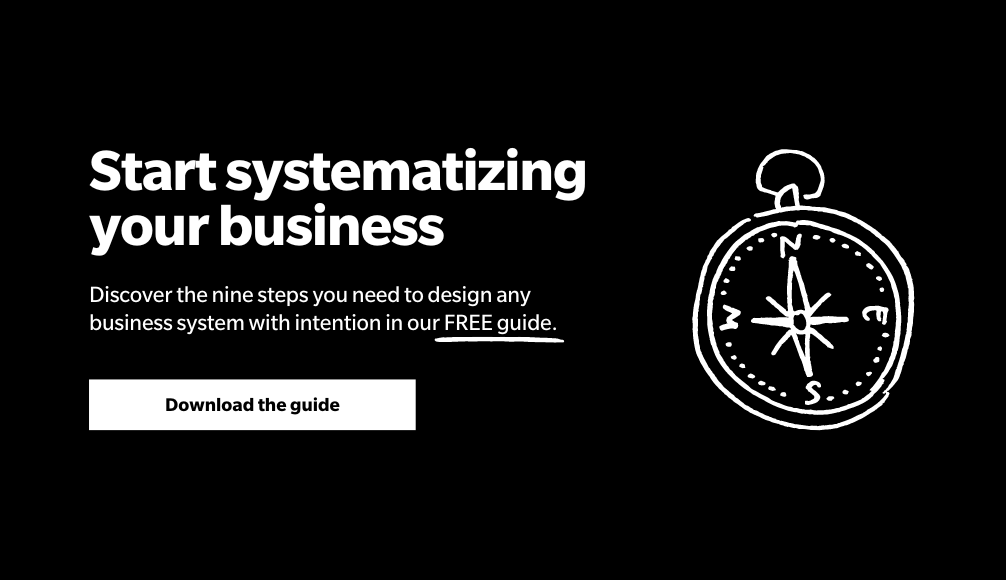Most small business owners come to us because they believe they want systems, but they don’t yet realize something important: Their business is already built around systems. It’s just that some of those systems aren’t producing the results they want.
Everything that happens in your business is the byproduct of a system that you’ve created—whether you realize it or not—and it'll likely yield the same result, day in, day out. And if that result isn’t part of your vision, it’s actually damaging your business.
So how can you change your perspective in a way that will ultimately give you more control, create a blueprint to develop your business sustainably, and ultimately build a business that doesn’t rely on you? Apply systems thinking like a NASA engineer.
Even if you’re not that interested in exploring galaxies far, far away, you’ll hopefully still see how orchestrating the first journey to the moon speaks to the value of systems. Though it might not seem like your business has much in common with Mission Control, the systems you use can have just as much of an impact as the systems NASA used at the first moon launch more than 50 years ago.
What is systems thinking in business?
A business that works is a holistic set of connected systems that make your operations run efficiently, support your team and deliver value to your customers. So the first step to systems thinking is to acknowledge this connectedness. The second step is to accept that your systems, like your business, are a reflection of your skills, life experience and personality. Whether or not you know it, you’re already a systems engineer.
Do you think Gene Kranz, the flight director of the Apollo spacecraft, had a different approach to system design than Steve Jobs? You bet. And it’s not just because one managed Houston’s Mission Control and the other built computers. They were two people who thought differently, had different values, possessed unique skill sets and built their management teams within different organizational cultures. So when you think about the business you run and the type of leader you are, start by asking some of the following questions as an exercise.
- What sort of system engineer am I?
- Who drives the systems in my business? What skills do they have and how much supervision do they need?
- Do I quantify the intended results of my systems and measure their effectiveness?
- Do I have a culture where I go to work each day to eliminate weak spots and improve our results?
- Do I consider risk when planning, and do I have contingency plans in place?
Your answers will help you understand the way you think, design, implement and test your business systems. If you’re not the one driving the systems in your business, why not? If you aren’t quantifying the results that your company achieves, how do you know how effective your systems really are?
As a business owner, the kinds of systems you gravitate toward reflect your own strengths and weaknesses as the driving force in your business. And while you may have the best systems you can think of, they may not necessarily be the best systems for your specific job.
The true entrepreneur in you wants to build long-term value instead of just managing the next problem on your list. You want—and deserve—to be able to focus on the future while managing your systems in the present. It’s a difficult feat: balancing the tension of ensuring everything is in its place with the sum of those finely tuned systems known as “your business.”
But this shouldn’t feel like rocket science. Let’s consider a business model that’s simpler than flying spaceships to the moon or building computers: How about cooking a hamburger?
Unlike most small business owners before him—and since—Ray Kroc went to work on his business, not in it. He began to think about his business like an engineer working on a pre-production prototype of a mass-producible product. He began to reengineer McDonald's decades before the word and the process came into fashion.
Michael Gerber, "The E-Myth Revisited"
In your business, you’re the lead systems engineer—you’re Houston—whether you know it or not. And a Mission Control without systems leads to chaos, leaving you feeling overwhelmed because your business is too reliant upon you.
Seeing the strengths and weaknesses of your existing systems can be difficult without an outside perspective. If you’d like to speak with a coach about how to develop stronger systems in your business, reach out to us.





Comments